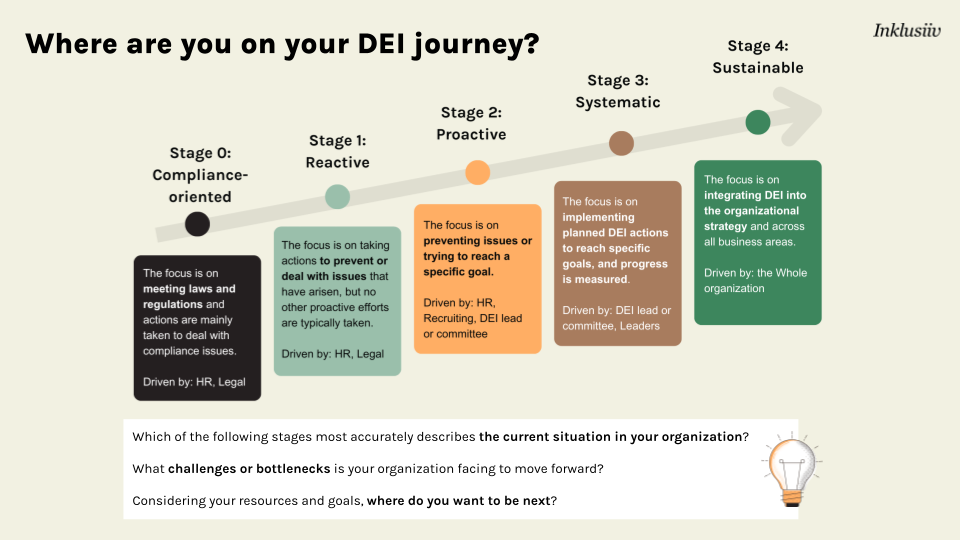In 2024, the importance of robust DEI planning cannot be overstated. For those entrusted with steering DEI efforts within their organizations—here are a few tips to navigate the terrain and ensure your DEI strategy is primed for success in 2024.
In the past months, notable discourse has emerged, casting doubt on the effectiveness and importance of investing in DEI initiatives. Critics rightly point out that when DEI work is executed inadequately, it risks being perceived as superficial or ad-hoc, failing to truly embed itself within the organizational culture. DEI initiatives cannot create organizational change when they are:
- Tokenistic
- A response to a trend
- A one-time project
- Reactive
Instead, our DEI work needs to be:
- Inclusive across different functions and levels
- Adapted to the needs of individuals and the organization
- A change management effort
- Embedded into the system and organizational strategy
In order to achieve true DEI outcomes, it is important to move away from reactive and project based approaches towards a more strategic and integrated organizational strategy for DEI. Here are our recommendations for what to consider in the process.
- Identify your starting point
- Set your goals and metrics
- Get your leaders involved
- Lock in your resources
- Know what your employees care about
1. Identify your starting point
To chart a successful DEI trajectory, understanding your organization’s current state is paramount. You can assess your current state of DEI by conducting assessments of employee experiences and DEI maturity.
Analysing employee experiences with a DEI survey can reveal the current level of diversity and experiences of inclusion felt by different groups in your organization. There is no one size fits all solution to DEI, so gathering data on your employees’ experiences is important for identifying your own organization’s priorities for action.
Meanwhile, a current state assessment can help identify your current level of DEI maturity and help you to understand what you are already doing well, and what you need to develop to ensure your DEI efforts are sustainable.
Establishing these two baselines provides a solid foundation for informed strategy development.

To better understand your organization’s position on the DEI journey, consider the following stages:
Stage 0. At this stage, the focus is primarily on meeting legal requirements and regulations related to DEI. Policies and practices are in place to ensure legal compliance, but little proactive effort is made beyond this.
Stage 1. Organizations in this stage address DEI issues as they arise, often in response to external pressures or incidents. While there is recognition of DEI challenges, efforts tend to be ad hoc and crisis-driven rather than systematic or strategic.
Stage 2. Organizations proactively tackle DEI issues and set measurable goals.
Stage 3. At this stage, organizations have implemented planned DEI actions to reach specific goals, and the progress of those efforts is measured.
Stage 4. This final stage is achieved when organizations focus on integrating DEI into the organizational strategy and across all areas of the business.
Reflect on your organization’s current stage with the following questions:
- Which of the stages most accurately describes the current situation in your organization?
- What challenges or bottlenecks is your organization facing to move forward?
- Considering your resources and goals, where do you want to be next?
2. Set your goals and metrics
Clear goals and metrics can help you assess whether your DEI efforts are taking you in the right direction. When charting the course for your DEI journey, it’s essential to define strategic and realistic goals that have a clear purpose. Without this clarity, organizations may encounter significant resistance along the way.
The foolproof way to set goals is to consider what DEI means within the context of your organization. Supplementing that by analyzing patterns in diversity data and listening to employee perspectives allows you to tailor your goals effectively, ensuring they resonate across the organization.
Accountability and evaluation are equally vital components of a successful DEI strategy. Without mechanisms in place to track progress and measure outcomes, initiatives may falter and lose momentum over time.
Metrics should encompass various dimensions of diversity, equity, and inclusion. Some useful DEI metrics to track may include: representation across various demographic categories, employees’ perceptions of inclusion, pay equity, and employee engagement.
3. Get your leaders involved
Diversity, equity, and inclusion can be advanced in all areas of an organization, from products and services to culture and values. In order for DEI to truly become sustainable, DEI efforts must be driven by the entire organization. This includes the executive and leadership teams.
While leaders may delegate many tasks, leaders cannot delegate the entirety of DEI responsibility, given their crucial role in it. Research highlights that leaders’ actions and statements significantly influence employees’ sense of inclusion, accounting for up to 70% of their perception (HBR 2020).
Senior leadership should articulate clear DEI goals and priorities that align with the company’s overarching mission, values, and strategic objectives. Moreover, leaders must allocate adequate resources to support DEI implementation, recognizing it as a long-term investment. Leaders must lead by example through their words, actions, and decisions, setting the expectation for desired behaviour.
4. Lock in your resources
One of the primary reasons why DEI programs often fall short of their intended outcomes is the insufficient allocation of resources. As highlighted by Culture Amp, a mere 34% of respondents feel that their organization possesses the necessary resources to effectively support DEI initiatives. Interestingly, organizations where resources are perceived as adequate tend to receive higher ratings for equity and inclusion from employees.
It’s essential to recognize that resources extend beyond mere financial investments. DEI efforts also demand a comprehensive allocation of time and staffing.
To facilitate this shift, organizations must prioritize the deployment of resources in various forms. This includes hiring dedicated diversity officers, providing comprehensive training programs, crafting inclusive policies and investing in the necessary infrastructure and resources to support DEI progress.
5. Know what your employees care about
At its core, DEI is about meeting the basic employee needs of every individual within the organization. This means ensuring job security, physical safety, feeling a sense of belonging to the team, being able to be yourself at work, freedom from discrimination and harassment, manageable workloads, and fair compensation.
When communicating about your organization’s DEI goals, it’s better to refrain from solely relying on narratives emphasizing how DEI promotes talent attraction, engagement, or innovation. These aspects, while important, are secondary to addressing employees’ core needs of being included and feeling valued.
By moving away from vague and abstract notions and communicating DEI goals and benefits through what your employees care about, organizations can mitigate resistance and enhance buy-in.
Prioritize Now, Not Later
The temptation to defer DEI initiatives or delegate them to others within the organization is understandable. Staying stagnant at stage 0, fixated solely on meeting compliance requirements, seems like the path of least resistance. But waiting until DEI becomes a crisis is not a viable strategy. Instead, DEI must be recognized as a strategic imperative from the outset—integrated seamlessly into the fabric of the organization’s operations, rather than treated as a one-off siloed event or initiative.
It’s okay not to have all the answers. That’s where DEI consultancies can help. Ready to get your DEI work on track in 2024? Let Inklusiiv be your partner in creating a workplace where everyone thrives. Reach out to consulting@inklusiiv.com to start the conversation. Find out more about Inklusiiv’s DEI services here!
Want to learn about best practices straight from DEI leaders at top companies during 2024?
“Leading the change: Building effective DEI practices in organizations’ ‘ was the topic of the Inklusiiv Community March Connect Event. Inklusiiv Connect Events are a space to discuss and exchange ideas about game-changing strategies, best practices, challenges, and all things DEI with other like-minded individuals driving DEI change across their organizations, all served with a side of delicious breakfast.
Want to join future events? Simply by investing in any of our DEI services, you’ll unlock a year’s worth of access to our vibrant events, matchmaking opportunities, and best practices. If you’re an existing client and you are interested in joining, reach out to us at members@inklusiiv.com.

